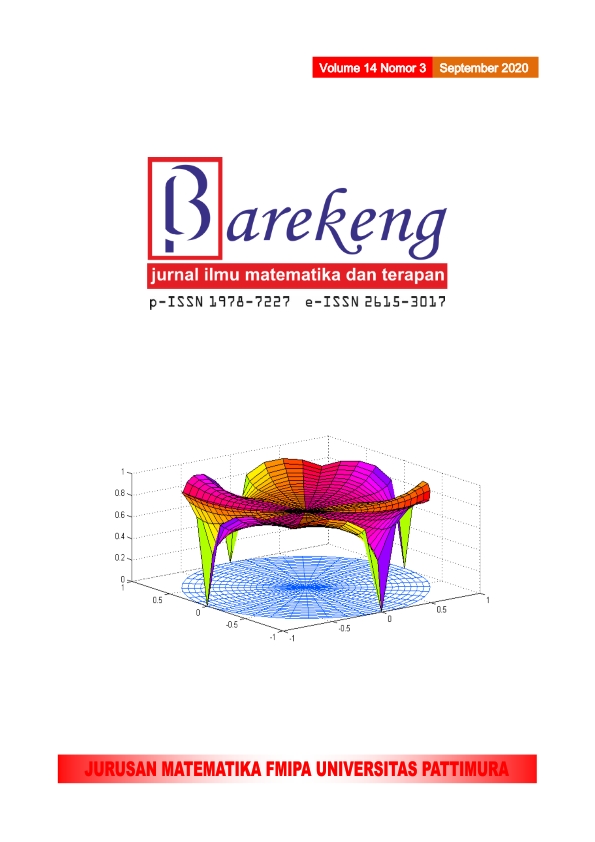A COMPARISON OF CENTRALITY MEASURES IN SUSTAINABLE DEVELOPMENT GOALS
Abstract
The Millennium Development Goals (MDGs), which began in 2000 with 8 goal points, have not been able to solve the global problems. The MDGs were developed into Sustainable Development Goals (SDGs) in 2015 with 17 targeted goal points achieved in 2030. Until now, methods for determining the priority of SDGs are still attractive to researchers. Centrality measure is one of the tools in determining the priority goal points on a network by using graph theory. There are four measurements of centrality used in this paper, namely degree centrality, betweenness centrality, closeness centrality, and eigenvector centrality. The calculation results obtained from the four measurements are compared dan analyzed, to conclude which goal points are the most prior and the least prior. Furthemore, in this paper we present other example with simple graph to show that each different centrality calculation possibly resulted different priority node, the calculation of this illustration is done using a Python’s library named NetworkX
Downloads
References
D. L. Blanc, “Towards Integration at Last? The Sustainable Development Goals as a Networks of Targetsâ€, Sustainable Development, vol. 23, no. 3, pp. 176–187, May-Jun 2015.
U. Brandes, “A Faster Algorithm for Betweenness Centralityâ€, Journal of Mathematical Sociology, vol. 25, no. 2, pp. 163-177, 2001
F. Cadini, E. Zio, C. A. Petrescu, “Using Centrality Measures to Rank the Importance of the Components of a Complex Network Infrastructureâ€, In: Setola R., Geretshuber S. (eds). Critical Information Infrastructure Security. CRITIS 2008. Lecture Notes in Computer Science, vol. 5508, Berlin: Springer, 2008, pp. 155-167
C. Donninger. “The distribution of centrality in social networkâ€. Social Networks, vol. 8, no.2, pp. 191-203, June 1986
L.C. Freeman, “Centrality in Social Network Conceptual Clarificationâ€. Social Networks, vol. 1, issue 3, pp. 215-239, 1978-1979
N. Meganathan, “Eigenvector Centrality-Based Mobile Target Tracking in Wireless Sensor Networks†In N. Kamila (Ed.) Handbook of Research on Wireless Sensor Network Trends, Technologies, and Applications., Hershey PA: IGI Global, 2017, pp. 395-412
K. H. Rosen, Discrete Mathematics and Its Applications, 7th Edition, New York: McGraw-Hill Companies, Inc., 2012
M. Tsvetovat and A. Kouznetsov, Social Network Analysis for Startups, Sebastopol: O’Reilly Media, 2011
X. Zhou and M. Moinuddin, “Sustainable Development Goals Interlinkages and Network Analysis: A Practical Tool for SDG Integration and Policy Coherenceâ€, Institute for Global Environmental Strategies (IGES) Research Report, 2017
A. Lange, Centrality in Strategic Transportation Network Design, An application to less-than-truckload networks. Wiesbaden: Springer Gabler, 2019
Authors who publish with this Journal agree to the following terms:
- Author retain copyright and grant the journal right of first publication with the work simultaneously licensed under a creative commons attribution license that allow others to share the work within an acknowledgement of the work’s authorship and initial publication of this journal.
- Authors are able to enter into separate, additional contractual arrangement for the non-exclusive distribution of the journal’s published version of the work (e.g. acknowledgement of its initial publication in this journal).
- Authors are permitted and encouraged to post their work online (e.g. in institutional repositories or on their websites) prior to and during the submission process, as it can lead to productive exchanges, as well as earlier and greater citation of published works.






1.gif)



